In October 2002, my wife, her sister, a friend and I went on the Food of the Gods Festival Tour in Oaxaca City. We booked the tour and the flight through Vista World Travel. Unfortunately, this tour is no longer available. The following is a report on that trip.
Saturday, October 5 We boarded a Mexicana flight to Mexico City in San Antonio. My sister-in-law was rewarded the full search upon boarding the plane. On our landing in Mexico City, with perfect weather and no wind, the pilot overshot the landing zone then touched down on the mains and dropped the nose hard at which time the plane lurched to the side and I thought he was going to lose it. We went through immigration and got our visas stamped and then went through another immigration for some reason on the way to the next gate. We were relieved to find that our flight to Oaxaca would not be on the same aircraft that had suffered the hard landing. We arrived in Oaxaca without further incident. My sister-in-law gets her bags searched by customs (she always gets searched). We were met by Roberto Gavidia and company from Oaxaca Tours at the airport and transported to our hotel, the Hostal de la Noria. We picked this hotel because it is only 2 blocks from the zócolo.
We were happy with the Hostal de la Noria which is located a block from the zócalo. The hotel had very firm beds, but we have come to expect that in Mexico. There is an interior courtyard, where you can dine or have a drink. Only a few rooms open onto the courtyard
|
|
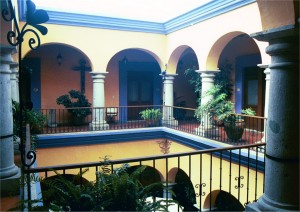 |
There was a cultural walking tour planned for Saturday afternoon but we knew in advance that our arrival would be too late to take advantage of this. No big deal. Our first dine-around was scheduled for Saturday evening. The dine-around is a lunch or dinner at a restaurant with a prearranged special menu. The menus of the 5 dine-arounds are coordinated to provide a well-rounded sampling of as many Oaxacan dishes as possible. There are no substitutions. The meals are included in the price of the tour and there were 5 of them at 5 different restaurants. We were given a package of vouchers at the hotel for these meals and for other items on the tour. We had been given the choice of early or late dining. So all you had to do was show up at the restaurant at the right time either singly or in groups and present your voucher to the restaurant. 4 of the restaurants were within walking distance but we were bussed by Oaxaca Tours to one restaurant which was a couple of miles out of town. Tonight's dinner was at El Naranjo, a block and a half from the zócolo.
Iliana de la Vega is the chef at El Naranjo. She greeted her guests personally and presented us with a menu listing the courses of our planned meal. This was a nice touch.
|
|
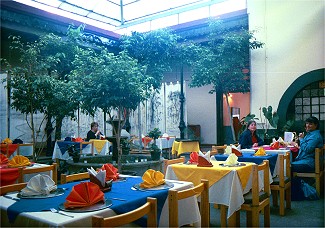 |
Sunday, October 6 According to the tour documentation, a daily American breakfast at the hotel is included and we had vouchers for these. Did the Gods eat an American breakfast? I don't think so, and we weren't going to either! Fortunately, our hotel didn't hold us to it; they let us order whatever we wanted. Since we were planning to eat our way through Oaxaca I went for a light breakfast and had the orden de frutas each day. October is a little early in the season for some fruits, so the pineapple and oranges were a little tart. My wife ordered fried eggs each day presented in various Mexican styles. The others had yogurt or pan dulce or other things. The hotel restaurant was full of bikers this morning who were here for some BMW convention.
We walked to the Hotel Camino Real for a 9:30 am introductory lecture by chef Iliana de la Vega. This event was included in the basic tour package. The Camino Real is housed in a large former monastery and our
|
|
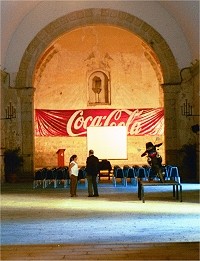 Coca Cola banner and motorcycle |
Iliana covered some of the history of Oaxaca and its food products and cuisine. She mentioned that squash, corn, and beans are known as the Oaxacan trinity and are grown and cooked together. Amaranth, a grain, was banned in 1516 by the conquistadors due to its use in pagan ceremonies but is still being grown and used by the indigenous population. Amaranth is higher in protein than corn and its protein is of higher quality. It is now being used in candied Day of the Dead figures. She then presented slides of the many Oaxacan peppers and other foods. A member of the audience asked if she had written a book. She said she was working on one.
Immediately following the lecture we attended a seminar by Ofelia Banderas on medicinal uses of Pre-Hispanic Herbs. This was an optional event at US$12 per person. She brought samples of fresh herbs and medicinal products that were made from processed herbs. As it turns out, some herbs are difficult to find even in Mexico, sometimes they go by different names in different areas (try to use the latin name), and some remedies require the combination of several herbs. All of this makes the use of processed products more attractive. Some of the processed products already contain the combination of herbs used for a particular remedy. We had to leave the seminar a little early to make it to our 2nd dine-around at Palapa de Raul.
To catch the tour bus to Palapa de Raul, we met at the flag pole in front of the Catedral, the usual meeting place for several tour events. Palapa de Raul is a couple of miles out of town, I think north on hwy 190 then turn right immediately after crossing an overpass at the escuela sign, then turn right again at the first opportunity. There are a couple of dining areas, some
|
|
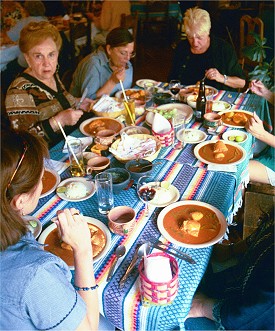 |
At 3:30 pm we gathered at Philately Museum (the Stamp Museum) for an Ice Cream and Exotic Fruit Tasting. This was an optional event for US$12 per person. The gathering was in a lovely courtyard behind the museum. There were about 30 guests and about 7 people participating in the presentation. Our guide, Roberto Gavidia, translated for us. However, the lady giving the presentation spoke very clearly in Spanish so that many of us could understand what she was saying. We sampled or viewed a number of different fruits including 3 kinds of bananas, 2 kinds of cactus tuna, guanabana, níspero, sugar cane, 2 kinds of zapote, mamey, ciruela, guayaba.
After sampling the fruit, we began the tasting of 8 varieties of Oaxacan ice cream. The varieties included rose, leche quemada, guanabana, mescal, egg custard, and cactus tuna. The leche quemada was a peculiar flavor made from burnt milk. The first bite tasted like an ashtray. After the initial shock, it began to taste a little better but I would not call it good. Thinking that it might have been a bad batch, I tried this flavor later at an ice-cream stand. The flavor was identical, it must be an acquired taste. You can try these flavors and more at Socrates Square in front of the Basilica de la Soledad, 1 blk N and 5 blks W of the NW corner of the zócolo. There are about 8 little ice-cream stands there.
Here are some photos of the ice-cream and fruit tasting.
For dinner, we try one of the zócolo restaurants, El Portal de la Soledad, and it is very nice. Upscale atmosphere and service, delicious food, and quite reasonable.
Monday, October 7 We go to the flagpole and meet for the 10:30 am Benito Juaréz Market Tour. This is an optional tour for US$12 per person and many have signed up for it. We actually visited three large markets on this tour. The Benito Juaréz Market occupies the inner spaces of a city block and is located 1 block south of the SW corner of the zócolo. Oaxaca Tours has enlisted the help of several guides and we break up into groups of about 7, each with their own guide. Our guide is Dra. (of anthropology) Sylvia Perez-Ramirez. She quickly whisks us off to the market, 2 blocks away. She pauses at La Compañia de Jesus, a Jesuit cathedral located at the SW corner of the zócolo. She explains the plight of the old decaying structure. The Jesuits are gone and by Oaxacan law the building belongs to those who have resided on the property for the last 90 years, which is something like 200 individuals. The state can't take control of it and the owners can't rebuild it either.
Sylvia also informs us of the failure of the corn crop this year due to dry conditions and the serious impact this has on the residents of remote regions. She points out that the length of the rainy season has been declining in recent years which has disturbed the agricultural growing season in this high desert area.
|
|
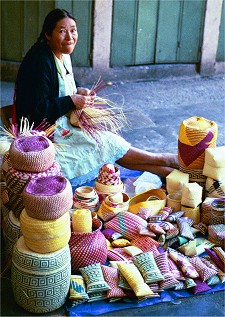 |
20 de Noviembre is dominated by baked goods. When we exit this market we proceed along the shops that line the perimeter of the block. Sylvia points out the brightly colored woven placemats that she says are easy to clean. Along the south side of the 20 de Noviembre market is Chocolate Street, Mina. Along Mina are several chocolate-making companies. We stop at Chocolate La Soledad and Chocolate Mayordomo to try samples, watch the chocolate-making process, and purchase chocolate and moles.
We proceed another half a block south to the Mercado de Artesanias, where there is much clothing for sale. Sylvia turned the group loose to shop for awhile and I took the opportunity to ask her some questions about the best seasons for various fruits in Oaxaca. I'll add some information about this later.
We have been winding in and out and around the markets and are all turned around but actually we have only covered 3 city blocks. Sylvia reorients us by returning back through the two markets in a straight line toward the zócolo. Excellent job, Sylvia. Soon we would be repeating the tour on our own.
After the market tour, it is time for our third dine-around which is lunch at Restaurante Marco Polo. Marco Polo specialized in fresh seafood flown in daily. Dining is in a pleasant outdoor garden setting in view of the outdoor
|
|
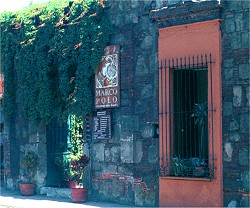 |
Then we revisited the markets on our own for purchasing and photo-taking. We return to our hotel, Hostal de la Noria, for supper where we discover that they have a talent for dishes featuring huitlacoche (corn fungus).
Tuesday, October 8 Breakfast at the hotel again. We have discovered that if you want your Mexican breakfast spicy, you must ask. Picante, por favor. Then it was back to the Juárez market where this time we walked every single aisle of the market. At lunch we met Stan and Diana at their favorite hangout, La Primavera, on the zócolo. Stan recommended the Consomé Xochitl, which was wonderful.
Next we gather at the flagpole for the 2:30 - 5:30 pm Monte Albán tour.
|
|
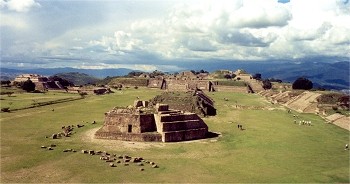 |
For dinner we try another restaurant on the zócolo, Casa de la Abuela. The menu is somewhat limited and some prices are higher but the food is good.
In the evening we attended a free concert (not part of our tour) at St. Agustín Cathedral, where a string sextet played music by Mozart and others.
Wednesday, October 9 This is a light day as far as our Food of the Gods Tour. We have only an evening dine-around scheduled. For lunch we try another zócolo restaurant, Terranova. It is okay.
In the afternoon, we meet Ron Mader, webmaster of planeta.com, at Decano. Decano is a restaurant/bar on 5 de Mayo that is featuring 2 for 1 drinks on Wednesday. We have margaritas and they are the best of the trip.
|
|
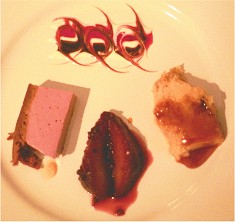 |
Thursday, October 10 Three in our group have cooking classes today from 9:30 am to 2:00 pm. The classes are optional at a cost of US$75 per person. My wife, Nancy, has a class with Iliana de la Vega that takes place in her restaurant kitchen at Restaurante El Naranjo. Polly and Leah have a class with Mariana Arroyo. They are taken to a private home outside of the city for this class.
Our fifth and final dine-around is dinner at Restaurante Catedral. We should have carried our dine-around menu with us for this dinner. Our previous four meals had all featured at least two appetizers before the main entrée. Here, our first appetizer was a crepe filled with huitlacoche with chile
|
|
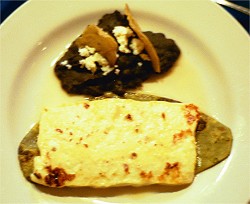 |
Friday, October 11 The last event on our tour schedule is the Craft Village Tour from 9:00 am to 1:00 pm. This is an optional event for US$20 per person. We meet at the flagpole to board the bus that takes us to Ocotlán de Morelos (market day and a beautifully restored church and museum), Santo Tomás Jalieza (weavers' market), San Martín Tilcajete (alebrijes shops), and San Bartolo Coyotepec (Oaxacan black pottery). Four hours was insufficient for this tour.
|
|
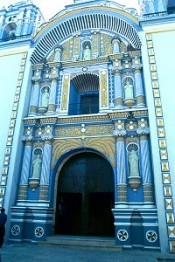 |
The four craft towns are located on or near hwy 175 south. We began the tour with a 20-minute drive to the most remote destination, Ocotlán de Morelos. The Ocotlán zócolo was filled with stalls for the weekly market day, many of which were displaying crafts. We also visited the Dominican church and former convent which has recently undergone large-scale restoration funded largely by painter Rodolfo Morales. Sr. Morales was a resident of Ocotlán. He died last year but created a foundation that continues with improvements and maintenance of the church/exconvent/museum and grounds.
Restored façade of the |
Our next stop was Sto. Tomás Jalieza, where we visited a crafts market and shops featuring works by the local weavers.
The third stop was at San Martín Tilcajete, where several artisans were selling alebrijes (brightly painted whimsical carvings made from copal). The term alebrijes originally referred to only the alien-looking figures but now is used to refer to all of the painted carvings in this style. We were able to see the craftsmen at work while viewing and purchasing their products.
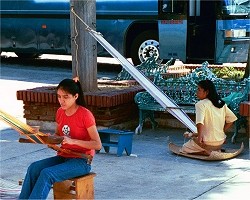 |
|
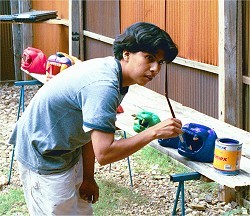 home/shop in San Martín Tilcajete |
The last stop was the shop of Doña Rosa in San Bartolo Coyotepec, the Oaxacan black pottery village. Pottery made from the clay found here has been unearthed in ancient Zapotec archaeological sites. Up until the 1950s, the pottery was brown in color and was used for utilitarian purposes. One important use was for holding the mescal in large (about 3-gallon) vessels. These were strapped to the backs of burros for transporting the liquor from remote distilleries into the villages for sale. In the 1950s, plastic jugs were introduced and replaced the use of pottery for this purpose due to their lower cost and weight. Searching for a new market for her pottery skills, Doña Rosa experimented with new methods to create a more attractive pottery that could be marketed for its beauty rather than its utility. Using the same local clay, she developed a technique of producing a finer surface finish by hand-rubbing the exterior and firing for a shorter period of time. (One source says this also involves diesel fuel and some shops use black shoe polish.) The product is not suitable for use with liquids or cooking but is uniquely attractive. Her techniques were kept secret for awhile but eventually other artisans figured out how to produce the pottery. We were treated to a demonstration of pottery-making by Doña Rosa's son. The shop had a large selection of pottery for sale at reasonable prices. The pottery is not very durable, especially the perforated designs and requires care in packing. Most of what we purchased was broken during the trip home. I would suggest bringing an empty hardshell suitcase and some sturdy cardboard boxes for packing pottery.
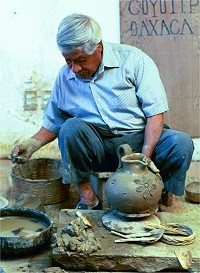 by Doña Rosa's son |
|
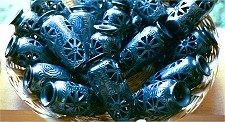
|
Saturday, October 12 No events were scheduled for our final day in Oaxaca. Our flight departed at 4:00 pm and checkout time was 1:00 pm, so we left the hotel at 1:00 pm and took a taxi to the airport. The taxi was a Suburban that could carry all our baggage and cost US$15. Oaxaca Tours no longer provides return transportation to the airport because people were wanting to arrive at the airport a different times and arranging their own transportation anyway. It is a good idea to arrive for Mexicana flights quite early since they overbook.
Reflections Overall we were very pleased with the Food of the Gods Festival Tour and our stay in Oaxaca. The tour provided an intensive introduction to Oaxacan cuisine that we would have been unable to duplicate in such short a period on our own. Of particular value were the five dine-arounds. These were coordinated to present us with a wide variety of Oaxacan dishes from a variety of sources. They were delicious, enlightening, and fun. I also liked having the ability to tailor the tour to our own specifications by selecting or rejecting activities from the list of options, and then paying only for what we got. Also, the tour schedule left us with enough time to do some exploring on our own.
We all enjoyed the tour and I feel comfortable recommending the tour to those who wish a thorough introduction to the cuisine and culture of Oaxaca.